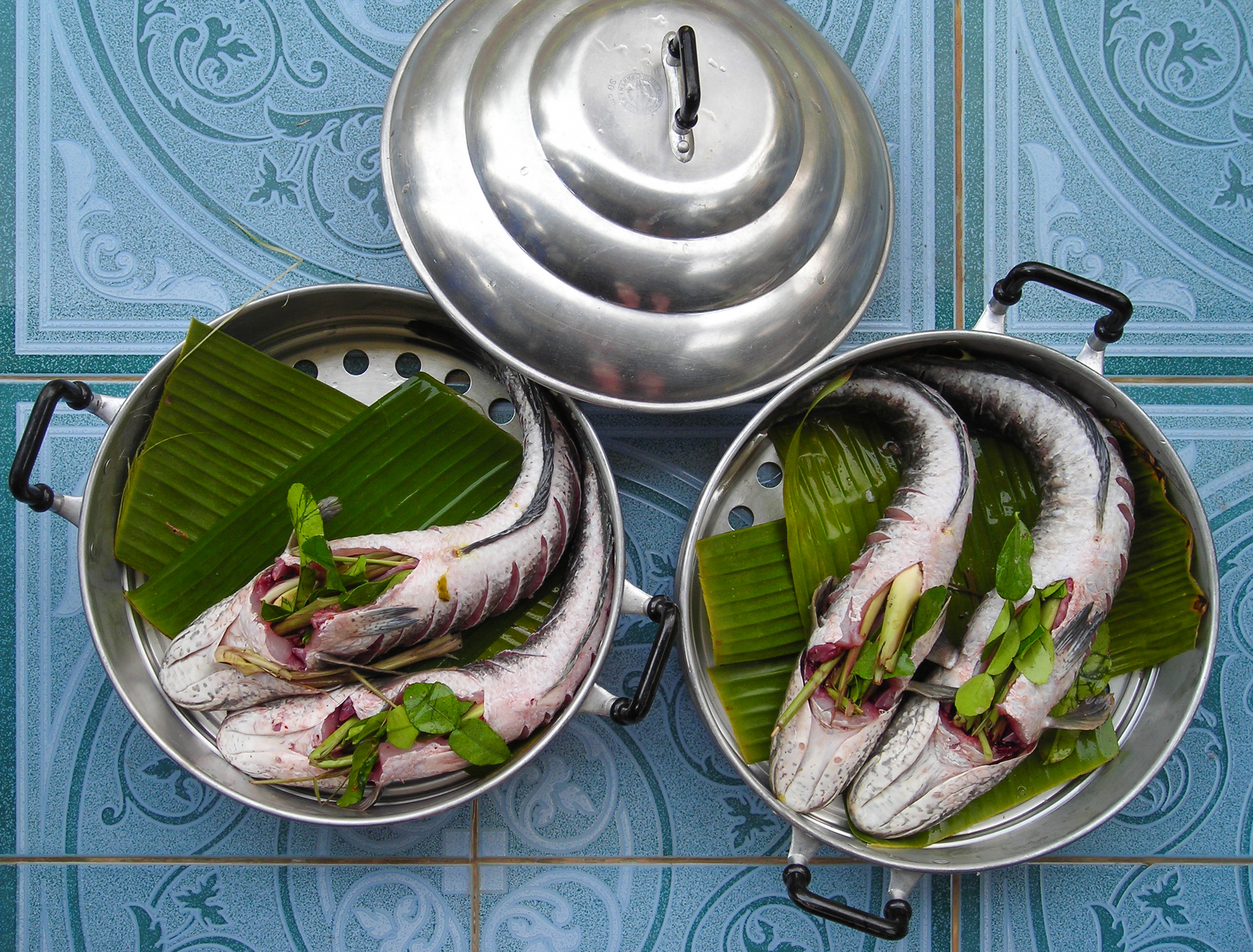|
Pakhala
Pakhaḷa ('','' ) is an Odia cuisine, consisting of cooked rice washed or lightly fermented in water. The liquid part of the dish is known as Toraṇi (). It is popular in the state of Odisha and its similar version is eaten in the eastern regions like Chhattisgarh, Jharkhand, Assam, Bengal and southern regions of Kerala, Tamil Nadu, Andhra Pradesh, Karnataka. It is also known as pāntā bhāt in Bengal. It is a preparation that is consumed during summer, although many people eat it throughout the year, especially for lunch. It is popular among the public as it provides a refreshing food source during the hot climate and replenishes the nutrients in the body. A traditional Odia dish, it is prepared with rice, curd, cucumber, cumin seeds, fried onions and mint leaves. It is popularly served with dry roasted vegetables—such as potato, brinjal, badi and sāgå bhåjā or fried fish. Etymology The term "Påkhāḷå" is derived from Pali word "Pakhāḷitā" () as wel ... [...More Info...] [...Related Items...] OR: [Wikipedia] [Google] [Baidu] |
Panta Bhat
Panta Bhat or Poita Bhat ( ''Pàntà Bhàt''; ''Poĩta Bhat'' or পন্তা ভাত ''Ponta Bhat'') consists of cooked rice soaked and fermented in water. The liquid part is known as Toraṇi in Odia. It is a rice-based dish prepared by soaking rice, generally leftover, in water overnight. Traditionally served in the morning with salt, onion, chili and Aloo Makha/Alu Pitika ( mashed potato). It is consumed in eastern Indian states of West Bengal, Odisha ( Pakhala), Jharkhand, Chhattisgarh, Assam, Tripura and in the country of Bangladesh. Panta Bhat with Ilish ( Hilsha) is the National Dish of Bangladesh. It is a popular dish on the day of Pahela Baishakh or Bengali new year. It has been described in documents from 17th century, while the dish Pakhala from Odisha documents back to 10th century CE, and is known as the origin of this dish. Panta bhat has more micronutrients than fresh rice. It is traditionally considered as beneficial in conditions. History Anthropolog ... [...More Info...] [...Related Items...] OR: [Wikipedia] [Google] [Baidu] |
Odia Cuisine
Odia cuisine is the cuisine of the Indian state of Odisha. Compared to other regional Indian cuisines, Odia cuisine uses less Cooking oil, oil and is less spicy, while nonetheless remaining flavorful. Rice is the staple food of this region. Mustard oil is used in some dishes as the cooking medium, but ghee (made of cow's milk) is preferred in temples. Odia foods are traditionally served either on brass or bronze metal plates, banana leaves, or disposable plates made of Shorea robusta, sal leaves. Odia cooks, particularly from the Puri region, were much sought after due to their ability to cook food in accordance with the Hindu scriptures. Yoghurt is used in many of the Odia dishes. Many sweets of the region are based on (cheese). Ingredients and seasoning Rice is a major crop of Odisha along with wheat. Lentils such as pigeon peas and moong beans are other major ingredients. Indigenous vegetables used in Odia cuisine are pumpkin, gourd, Cooking plantain, plantains, ja ... [...More Info...] [...Related Items...] OR: [Wikipedia] [Google] [Baidu] |
Cuisine Of Odisha
Odia cuisine is the cuisine of the Indian state of Odisha. Compared to other regional Indian cuisines, Odia cuisine uses less oil and is less spicy, while nonetheless remaining flavorful. Rice is the staple food of this region. Mustard oil is used in some dishes as the cooking medium, but ghee (made of cow's milk) is preferred in temples. Odia foods are traditionally served either on brass or bronze metal plates, banana leaves, or disposable plates made of sal leaves. Odia cooks, particularly from the Puri region, were much sought after due to their ability to cook food in accordance with the Hindu scriptures. Yoghurt is used in many of the Odia dishes. Many sweets of the region are based on (cheese). Ingredients and seasoning Rice is a major crop of Odisha along with wheat. Lentils such as pigeon peas and moong beans are other major ingredients. Indigenous vegetables used in Odia cuisine are pumpkin, gourd, plantains, jackfruit, and papaya. Vegetables such as potat ... [...More Info...] [...Related Items...] OR: [Wikipedia] [Google] [Baidu] |
Jagannath Temple, Puri
The Jagannath Temple is a Hindu temple dedicated to the god Jagannath, a form of Vishnu in Hinduism. It is located in Puri in the state of Odisha, situated on the eastern coast of India. As per temple records, King Indradyumna of Avanti built the main temple of Jagannath at Puri. The present temple was rebuilt from the eleventh century onwards, on the site of the pre-existing temples in the compound, but not the main Jagannath temple, and begun by Anantavarman Chodaganga, the first king of the Eastern Ganga dynasty. Many of the temple rituals are based on Oddiyana Tantras which are the refined versions of Mahayana Tantras as well as Shabari Tantras which are evolved from Tantric Buddhism and tribal beliefs respectively. The local legends link the idols with aboriginal tribes and the daitapatis (servitors) claim to be descendants of the aboriginals. The temple is one of the 108 '' Abhimana Kshethram'' of the Vaishnavite tradition. The temple is famous for its annual Rat ... [...More Info...] [...Related Items...] OR: [Wikipedia] [Google] [Baidu] |
East India
East India is a region consisting of the Indian states of Bihar, Jharkhand, Odisha and West Bengal and also the union territory of the Andaman and Nicobar Islands. The states of Bihar and West Bengal lie on the Indo-Gangetic plain. Jharkhand is situated on the Chota Nagpur Plateau. Odisha lies on the Eastern Ghats and the Deccan Plateau. West Bengal's capital Kolkata is the largest city of this region. The Kolkata Metropolitan Area is the country's third largest metropolitan region. The region is bounded by Bhutan, Nepal and the state of Sikkim in the north, the states of Uttar Pradesh and Chhattisgarh on the west, the state of Andhra Pradesh in the south and the country of Bangladesh in the east. It is also bounded by the Bay of Bengal in the south-east. It is connected to the Seven Sister States of Northeast India by the narrow Siliguri Corridor in the north east of West Bengal. East India has the fourth-largest gross domestic product of all Indian regions. The regio ... [...More Info...] [...Related Items...] OR: [Wikipedia] [Google] [Baidu] |
Indian Subcontinent
The Indian subcontinent is a physiographic region of Asia below the Himalayas which projects into the Indian Ocean between the Bay of Bengal to the east and the Arabian Sea to the west. It is now divided between Bangladesh, India, and Pakistan. (subscription required) Although the terms "Indian subcontinent" and "South Asia" are often also used interchangeably to denote a wider region which includes, in addition, Bhutan, the Maldives, Nepal and Sri Lanka, the "Indian subcontinent" is more of a geophysical term, whereas "South Asia" is more geopolitical. "South Asia" frequently also includes Afghanistan, which is not considered part of the subcontinent even in extended usage.Jim Norwine & Alfonso González, ''The Third World: states of mind and being'', pages 209, Taylor & Francis, 1988, Quote: ""The term "South Asia" also signifies the Indian Subcontinent""Raj S. Bhopal, ''Ethnicity, race, and health in multicultural societies'', pages 33, Oxford University Press, 2007, ; Q ... [...More Info...] [...Related Items...] OR: [Wikipedia] [Google] [Baidu] |
Fish (food)
Many species of fish are caught by humans and consumed as food in virtually all regions around the world. Their meat has been an important dietary source of protein and other nutrients in the human diet. The English language does not have a special culinary name for food prepared from fish like with other animals (as with '' pig'' vs. ''pork''), or as in other languages (such as Spanish '' pez'' vs. '' pescado''). In culinary and fishery contexts, ''fish'' may include so-called shellfish such as molluscs, crustaceans, and echinoderms; but, more expansively, ''seafood'' covers both fish and other marine life used as food. Since 1961, the average annual increase in global apparent food fish consumption (3.2 percent) has outpaced population growth (1.6 percent) and exceeded the increase in consumption of meat from all terrestrial animals except poultry (4.9 percent), both combined (2.8 percent) and individually (bovine, ovine, porcine, et cetera). In ''per capita'' terms, f ... [...More Info...] [...Related Items...] OR: [Wikipedia] [Google] [Baidu] |
Potato
The potato () is a starchy tuberous vegetable native to the Americas that is consumed as a staple food in many parts of the world. Potatoes are underground stem tubers of the plant ''Solanum tuberosum'', a perennial in the nightshade family Solanaceae. Wild potato species can be found from the southern United States to southern Chile. Genetic studies show that the cultivated potato has a single origin, in the area of present-day southern Peru and extreme northwestern Bolivia. Potatoes were domesticated there about 7,000–10,000 years ago from a species in the '' S. brevicaule'' complex. Many varieties of the potato are cultivated in the Andes region of South America, where the species is indigenous. The Spanish introduced potatoes to Europe in the second half of the 16th century from the Americas. They are a staple food in many parts of the world and an integral part of much of the world's food supply. Following millennia of selective breeding, there are now over 5 ... [...More Info...] [...Related Items...] OR: [Wikipedia] [Google] [Baidu] |
Brinjal
Eggplant ( US, CA, AU, PH), aubergine ( UK, IE, NZ), brinjal ( IN, SG, MY, ZA, SLE), or baigan ( IN, GY) is a plant species in the nightshade family Solanaceae. ''Solanum melongena'' is grown worldwide for its edible fruit, typically used as a vegetable in cooking. Most commonly purple, the spongy, absorbent fruit is used in several cuisines. It is a berry by botanical definition. As a member of the genus ''Solanum'', it is related to the tomato, chili pepper, and potato, although those are of the Americas region while the eggplant is of the Eurasia region. Like the tomato, its skin and seeds can be eaten, but it is usually eaten cooked. Eggplant is nutritionally low in macronutrient and micronutrient content, but the capability of the fruit to absorb oils and flavors into its flesh through cooking expands its use in the culinary arts. It was originally domesticated from the wild nightshade species ''thorn'' or ''bitter apple'', '' S. incanum'',Tsao and Lo ... [...More Info...] [...Related Items...] OR: [Wikipedia] [Google] [Baidu] |
Saag
Saag also spelled sag, saagh or saga, is a leafy vegetable dish from the Indian subcontinent. It is eaten with bread, such as roti or naan, or in some regions with rice. Saag can be made from mustard greens, collard greens, basella or finely chopped broccoli along with added spices and sometimes other ingredients, such as chhena. In India, it is common, especially in the state of Odisha, where it is eaten with pakhala. In the Shree Jagannath Temple of Puri, saag is one of the dishes offered to Jagannath as part of Mahaprasad. Saag is also common in West Bengal and other regions of North India, where the most common preparation is sarson ka saag (mustard plant leaves), which may be eaten with makki ki roti, a yellow roti made with maize flour. ''Saag gosht'' or ''hariyali maans'' (spinach and mutton) is a common dish in the North Indian state of Punjab. In Pakistan, it is most commonly eaten in the Punjab province along with Makki ki roti, made from freshly ground corn f ... [...More Info...] [...Related Items...] OR: [Wikipedia] [Google] [Baidu] |









